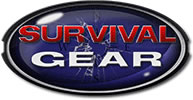Survival Kit List
A survival kit list starts with the container for the kit itself. This ideally will be a backpack or duffel bag - something easily carried while keeping your hands free. I've seen some folks using rolling duffel bags or suitcases. I don't recommend that approach as the wheels only work well on smooth pavement. Once you get on gravel, grass, or snow, they are nothing but heavy.
Your survival kit list should be broken into categories of food, water, first aid, hygiene, lighting, and shelter / warmth. These are the needs a survival kit should satisfy.
When it comes to food, you're not packing to feed an army for weeks on end. You want high calorie items that store well and require little or no preparation before consuming. Suggestions include protein bars, dried fruit, crackers, nuts, and granola bars. Food is fuel and while the average person can last a few weeks without it, I wouldn't recommend doing so.
Survival Kit List
The body can only go a few days without water so you'll need to plan for that on your survival kit list. One or two filled water bottles is a good start. After that, add in water purification tablets and/or a commercially made water filter system. This allows you to refill your water bottles with water you may find in streams, lakes, or even puddles.
Every survival kit should have a first aid component. Things to include would be adhesive bandages, burn cream, antibiotic cream, and elastic wrap for sprains. Tweezers are great for removing splinters. There are many premade first aid kits available online and in stores but be sure to inspect the contents and add in anything you feel is missing.
While people have been using leaves for centuries, most of us would appreciate having real toilet paper in our survival kits. Baby wipes are another great addition to the hygiene portion of your survival kit list. Consider adding a small bottle of hand sanitizer as well. Keeping clean reduces the risk of infections and illness.
While lighting might not be absolutely necessary for survival in many situations, it sure makes life easier when you can see what you're doing. LED flashlights and head lamps are preferred over incandescent bulbs because they draw much less energy and are considerably brighter. Glow sticks purchased from the dollar store are also good to have.
Being able to stay warm and dry is not only important for survival, it is a great boost to morale. So, be sure your survival kit list includes ways to stay out of the elements and start campfires. Rain ponchos and emergency blankets will do well to keep rain and snow off of you. Butane lighters, strike anywhere matches, and magnesium strikers all do well with starting fires. Be sure to also include some ready to use tinder, such as dryer lint.
Everyone's survival kit list is going to be unique to them and their individual circumstances. Read through lists such as outlined above and work to make your own that is perfect for you.

